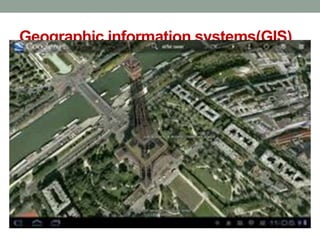
Remote sensing & gis
- 2. Geographic information systems(GIS) DEFINITION An organised collection of computer hardware, software, geographical data and personnel designed to efficiently capture, store, update, manipulate, analyze & display all forms of geographically referenced information.
- 3. GIS • Gives spatial information • Two types of data: Spatial data Non spatial data
- 4. GIS map Spatial data • Depicted as point, line or a polygon feature Non spatial data Attributes stored in a table as numbers or characters
- 5. Storing data • Vector formats- linear feature • Raster formats- stored as image- looks real. Line, polygon and point features • GIS takes care of features, attributes and layers.
- 6. Applications of GIS • Agrl development • Vegetative cover • Crop acreage and production estimation • Wasteland mapping • Forest area mapping • soil resources mapping • Ground water potential mapping etc…
- 7. Trends in GIS oNRM • Watershed Delineation • Waste land demarcation • Ground water resources • Identifying water bodies • Disaster areas
- 8. Modern tools for planning watersheds • DEM map( Digital Elevation Model) to represent continually varying surface by isolines or contours. Global system – WGS 84 In India - LCC Web portals – Google earth, Bhuvan(ISRO) Co ordinates taken in UTM plane India falls in 43, 44, 45,46 planes
- 10. DEM
- 11. DEM
- 12. Images on GIS
- 13. REMOTE SENSING
- 14. Remote sensing • Technique of obtaining information about an object through analysis of data collected without coming in touch with the object.
- 15. Stages in RS • Emission of EMR • Transmission, absorption and scattering of energy from source to earth’s surface • Interaction of EMR with earth surface • Transmission of energy from surface to remote sensor • Data output transmission, processing and analysis
- 17. Basic hypothesis • Any object on earth is having a unique spectral signature This helps to distinguish one object from another
- 19. What is Light?
- 20. What is Colour?
- 21. Why Do We See Colour? after Campbell, J.B., 1987. Introduction to Remote Sensing. New York: Guildford.
- 22. near IRblue green red Spectral Bands
- 23. A fundamental premise in remote sensing is that we can identify and learn about objects and features on the Earth's surface by studying the spectral characteristics of the radiation reflected (and/or emitted) by these features.
- 24. Colour Composite Displays • We typically create multispectral image displays or colour composite images by showing different image bands in varying display combinations.
- 28. Standard False Colour Composites
- 31. Feature True Colour False Colour trees and bushes olive green red crops medium to light green pink to red wetland vegetation dark green to black dark red water shades of blue & green blue to black urban areas white to light blue blue to grey bare soil white to light grey blue to grey Source: U.S. Department of Defense, 1995. Multispectral Users Guide. General Appearance of Surface Features on Colour Composite Images
- 32. What is Spatial Resolution? • The fineness of spatial detail visible in an image • Most affected by contrast • Determined by the sensor’s Instantaneous Field of View (IFOV) • “Resolution”
- 33. Low Spatial Resolution Spatial Resolution: 80 m File Size: 0.5 Mb Ground Dimensions: 33 x 33 km Image Dimensions: 418 x 418 Landsat Multispectral Scanner Image A
- 34. Medium Spatial Resolution Spatial Resolution: 30 m File Size: 0.5 Mb Ground Dimensions: 12.5 x 12.5 km Image Dimensions: 418 x 418 Image size required to cover area in A: 1.2 Mb (1100 x 1100 ) Landsat Thematic Mapper Image B
- 35. High Spatial Resolution Spatial Resolution: 1.5 m File Size: 0.5 Mb Ground Dimensions: 625 x 625 m Image Dimensions: 418 x 418 Image size required to cover area in A: 500 Mb (22,300 x 22,300 ) SPIN-2 Panchromatic Image C
- 36. Spatial Resolution: 500 m Terra MODIS August 24, 2002 NASA Earth Observatory
- 37. Spatial Resolution: 30 m Landsat 7 ETM August 27, 2000
- 38. Spatial Resolution: 30 m Landsat 7 ETM August 27, 2000
- 39. Spatial Resolution: 2.4 m QuickBird 1 September 11, 2002
- 40. Spatial Resolution: 0.62 m QuickBird 1 September 11, 2002
- 41. Instantaneous Field of View
- 42. Satellites • Geo stationary satellites Orbit in synchrony with earth’s rotation Altitude of 35000km Mainly for communication and meterology GEOS,METOSAT, INTELSAT,INSAT • Sun synchronous satellites All remote sensing resource satellites LANDSAT,IRS,CARTOSAT
- 43. GLOBAL POSTIONING SYSTEM(GPS) • GPS is a satellite based radio-navigation system established by US dept of Defence for military purposes. • 24 satellites and their ground stations involved. • Provides information on latitude, longitude,elevation and direction
- 44. GPS position • Unique position corresponding to a reference system • WGS 84 (global) • NAD 83 (US) • LCC (India) • NARSTAR satellites are involved
- 45. System • Handle device • Satellite • Ground station • Processing station 2D position – 3 satellites are involved 3D position – 4 satellites are involved
Notes de l'éditeur
- 36
- 38
